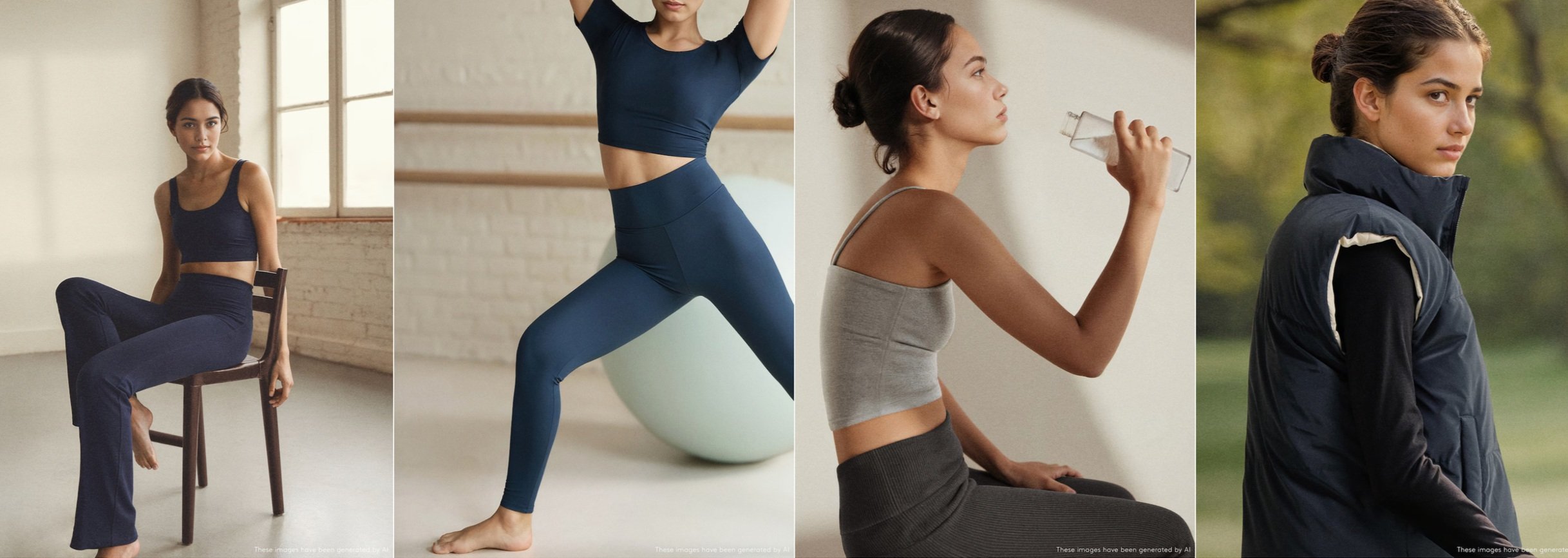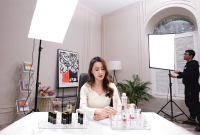Many industry voices consider how AI digital creations will undermine PDP authenticity, damage brand trust, and alienate customers.
This feels similar to the conversations we used to have around UGC imagery and potential loss of brand equity from 2015 to 2016.
Our fears about AI models and authenticity may be misplaced.
Much like UGC talent went from outlier to crucial brand ambassador at the forefront of trusted shopping; AI models may soon become a vital part of the brand ecosystem.
Authenticity in Constant Flux
Authenticity constantly evolves, heightened by generational shifts, cultural contexts, and technological advancements. Right now, we consider the early iterations of AI image models inauthentic, but with the right approach, transparency, and representation, AI models may soon represent the next step in authentic evolution.
Symbols and Simulations: What Is Real?
To understand this, we can take a nostalgic look back to the early 1980s, when Jean Baudrillard published his work Simulacra and Simulation. He described how simulations replace the reality they imitate in a world increasingly dominated by signs and symbols (replicas or signifiers of the real thing). Creating a world that he called the hyperreal.
A simple way to understand the hyperreal is a state where distinctions between reality and simulation collapse. In the hyperreal, images no longer refer to an external reality but represent themselves, creating a self-contained space that feels more “real” than reality itself.
While online social spaces exemplify this today, Baudrillard’s example of hyperreality (in the pre-internet era) was Disneyland.
The Disneyland Experience
Baudrillard used Disneyland as an example of symbolic simulation: a fabricated world of small-scale castles and main streets mimicking an artificial vision of America. Every sensory detail is carefully controlled, from piped-in bakery scents designed to evoke nostalgia to the illusion of free-roaming choice that’s really just commercial shopping and generational brand building.
The in-park experience is a rich example of symbolic simulation. Visitors (Customers) queue for hours for a photo with a cast member who vaguely resembles a Hollywood actor. But the simulation extends. The Hollywood actor, being one from a line of many actors, was chosen because they vaguely embody an unreal comic book character, in turn, shaped over decades by a rotating team of artists.
Despite these layers of abstraction, queues form, memories are made, and revenue flows. This staged paid-for event is crafted to feel unique and personal.
It works because the desire for authentic experience is so powerful that we willingly suspend disbelief.
The Joy of Symbolic Simulation
This model of symbolic simulation extends far beyond theme parks, underpinning many modern emotional experiences from the collective euphoria of a Taylor Swift concert (infinitely repeatable in location after location) to the spectacle of a sports championship Bus parade.
The more we invest our time, money, or energy, the more authentic the experience feels.
This same framework extends into the fashion world, where authenticity is a carefully crafted illusion—from an iconic campaign celebrating diversity that casts exclusively from the top 5% of the genetically gifted to a meticulously choreographed lingerie catwalk revamped to salvage declining sales. The artificial is ever-present.
Simulation and Performative Reality
At its core, fashion is built on the concept of simulation, crafting feelings of identity and self-expression through the act of purchasing. Brand experience sells us not just products but an idealised version of ourselves we will never be, a carefully curated illusion we willingly embrace.
What we view as Authentic will transition
GenZ’s + Y2K Revival:
Gen Z embraced Y2K fashion, not because they lived through it but because of its nostalgic appeal. The carefree era was defined by the media of the time (anxiety-calming sitcoms like Friends, for example—itself a simulation of idealised reality).
What began with sourcing vintage clothing quickly shifted to knock-offs, dupes, and Y2K-inspired fast fashion as the market adapted. The final aesthetic became a manufactured nostalgia shaped by curated media memories and consumerism.
Gen X’s Grunge Era:
In the mid-90s, Grunge was synonymous with authenticity. Plaid shirts, ripped jeans, and battered Dr Martens boots became the movement’s uniform. Like many teens, I intentionally scuffed my store-bought boots to mimic the lived-in look of my idols.
Few of us knew, except perhaps the most devoted Everett True readers, that Courtney Love’s ‘real and raw’ aesthetic was borrowed wholesale from a band member she admired. Grunge was a performative cosplay of a small Seattle subculture. Yet, within our friendship groups, it felt entirely authentic. We all thought we could smell an MTV sell-out.
The Era of Fluid Authenticity
Unlike Gen X, whose subcultures demanded deep, in-person loyalty led by (slow-moving) magazines and real-time access to events, Gen Z has always been online and moves fluidly through trends, blending aesthetics with ease. For them, authenticity comes from transparency, emotional honesty, and the freedom to embrace contradictions. Being ‘real’ means being confessional and earnest, no matter which trend they’re currently exploring.
Fashion Imagery: The Illusion We Accept
We know all fashion imagery is carefully staged. Yet, like Disneyland, we push this knowledge aside to enhance our enjoyment.
But what does this mean generationally, for authenticity in fashion imagery?
For Gen X, perhaps it was Peter Lindbergh’s laidback black-and-white portraits of the supermodels, heralded as raw and authentic. Yet these images were curated from a narrow selection of the most beautiful women judged by the aesthetic standards of the time.
For Millennials: authenticity was found in ad campaigns featuring unretouched skin, celebrated as real even while hair and makeup artists worked meticulously to create their perfectly imperfect look.
For those in between, perhaps it was the refreshing appearance of non-model Kate Moss, bringing a breath of fresh air to Croydon with her grungy style. Authenticity suddenly meant models could be plucked from obscurity and scouted at an airport with their parents. This was raw talent.
For Gen Z: the ultimate contradictions, it’s the pure love of Nepo Baby Models and everyday TikTok’s GRWM “Get Ready With Me” videos. These videos feel relatable, even though the audience knows they are carefully staged and edited.
From NepoBaby to Real/Raw
Many Gen Z models navigate the challenge of creating authenticity while being part of nepotism’s baby aristocracy. They learn not to focus on their immense privilege and the pressures of fame but to speak instead of the insecurity of walking into a room and feeling judged. They are immediately relatable and real.
So authenticity now means pairing up GenZ icon Kaia Gerber ( “The best piece of advice my Mum has ever given me is don’t do anything you don’t want to do”) with her supermodel mum Cindy Crawford, something Zara recently did in their hyperreal live shopping event.
The Hyperreal in Action: Zara Live Shopping
The event, billed as live, was entirely scripted and meticulously rehearsed. Viewers could interact and experience emotional connection by sending emojis into a simulated onscreen chat, creating the illusion of participation.
Despite being staged, the event blended relatability and aspiration. Two iconic, beautiful women who indirectly spoke to fears of ageing, youth and staying stylish, appealing to a broad audience. The experience, though fabricated, included real crew members, ‘behind the scenes’ also rehearsed, yet seemingly felt authentic to its viewers. Zara, like Disney, shows that even hyperreal simulations can resonate and help us to purchase products.
This ability to craft authenticity through simulation highlights the next frontier for brands: AI models.
Ai Models: The Next “Real” Authentic Trend?
Concerns about representation, body image, and diversity in AI are valid and need careful navigation. Still, history shows that these issues, seen as rigid barriers at the moment, consistently evolve as societal norms and perceptions shift.
What models represent the real ‘us’ has always been a carefully curated construct at the brand level.
Ai models may represent the next iteration of this construct. Infinitely customisable, they offer brands a new way to craft their vision of authenticity, blending practicality with aspirational storytelling.
Three Ways AI Models May Be Accepted in Fashion:
Exposure: The more we see AI models, the more familiar and natural they will feel, from real and representative ‘human’ models to the more unreal representations. What once seemed unfamiliar or even unsettling will become second nature over time.
Cross-Media Brand Integration: AI models can seamlessly appear in PDP, social commerce, and live shopping events, creating consistent and recognisable personas. This cross-platform presence may build a sense of authenticity and strengthen their role as part of the brand’s identity.
Shared Reality: As AI models “speak” (through captions or actual speech), they’ll craft relatable narratives. From digital clothing challenges to body image discussions, these stories will begin to resonate emotionally with audiences, fostering deeper connections.
What’s relatable about AI models won’t be their physical form but the stories they tell.
Ai Models as Future Brand
The aim is not to use AI models in isolated PDP imagery but to integrate them as dynamic brand assets that connect with audiences across platforms. While we’ve accepted the illusion of PDP models as ‘real’ in just a decade, AI models have the potential to redefine this space, seamlessly blending PDP, social media, and elevated content into a cohesive and impactful brand narrative.
Conclusion: Authenticity Is Not Tied to Reality
Putting aside current legal considerations, which brands will be the first to dominate this new space?
Are AI models simply the next chapter in fashion’s long history of creating aspirational illusions that are infinitely more manipulable and cost-effective?
Humans are exceptionally skilled at projecting emotions onto non-human entities, as anyone who has argued with a chatbot can attest. AI models, enhanced by artificial empathy (the ability to detect and respond to emotions), could deepen this connection, particularly as virtual try-ons and personalised shopping experiences become the norm for us as customers.
These evolving technologies may transform AI models into relatable and emotionally resonant brand ambassadors, amplifying their impact across digital platforms, not just at the PDP level.
As AI models become mainstream, we must consider how brands will adapt their vision to embrace this evolving definition of authenticity.




